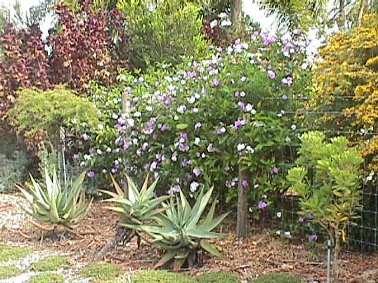Classification
Domain-Eukarya
Brunfelsia grandiflora is a
member of this domain because it is made up of eukaryotic cells. This means
that the cells contain membrane bound organelles. Other characteristics of
Eukarya are that the DNA of the cells are wrapped in a nuclear envelope, the
organisms are multicellular (though, there are unicellular eukaryotes as
well), and members of this domain are larger than those in the domains of
Bacteria and Archaea.
Below is a morphological phylogenetic tree I
created via paint and PowerPoint of the three domains and families of
Eukarya .
.
Kingdom-Plantae
Members of this kingdom are multicellular and
their cells have walls made of cellulose. Members of this kingdom also have
cells called chloroplasts. These are green in color and enable the plant to
photosynthesis, which is how they produce their food, i.e. glucose. Any
excess food is stored as starch. Plants absorb nutrients from the soil via
roots. The leaves have a waxy covering, called a cuticle, which is used to
prevent water loss. They respire via openings in the leaves called stomata.
Phylum-
 Magnoliophyta (Angiosperms)
Magnoliophyta (Angiosperms)
Members of this phylum are the flowering plants,
which are the dominant form of plants, and have the most diversity out of
the rest of the phyla. They produce fruits and flowers to attract animals
and insects for pollination and seed dispersal. For example, let’s say an
animal comes and eats a berry. Because it cannot digest the seed, the animal
will deposit it when it defecates in a different location.
Angiosperms have alternation of generations, gametophyte and sporophyte. The sporophyte generation, which is diploid, is dominant. This means that the organisms spend most of their lives in this form. Pollination of angiosperms is indirect and the plants go through double fertilization, but this will be discussed further in the reproduction section. To view other angiosperms, visit the Sweet Orange and the Sweet Potato.
Class-Magnoliopsida (Dicots)
The plants that belong in this category usually
produce flowering parts in multiples of four or five. Their veins in the
leaves appear netlike and the vascular tissue forms in a ring. The plants’
embryos have two cotyledons, which develop into the first leaves of the seed
as it grows. Dicots usually have a main root, called a taproot, with smaller
roots branching off of it. The pollen from these plants typically have three
pores, or openings.
Order- Solanales
Solaneles is an order under the flowering plants.
It is under the Asterid group of dicotyledons. Some characteristics of the
Asterids are that the petals are fused together and that there are less
stamens than petals. The order Solanales contains the families Solanaceae,
Convolvulaceae, Montiniaceae, Sphenocleaceae, Hydroleaceae.
Family- Solanaceae
|
Brunfalsea grandiflora
belongs to
the Solanaceae (nightshade)
family. These plants are
found in tropical areas and
a lot come from Australia,
Central and South America.
This family consists mainly
of herbs, but there are
still shrubs and trees in
this group. Many common
foods such as tomatoes,
potatoes, and peppers also
belong to this family. The
flowers of these plants, and
as is the case of B.
grandiflora, usually
form in groups, though the
flowers can also grow alone.
Members in this family often
have poisonous parts, which
holds true for B.
grandiflora.
The morphological tree below shows the relation B. grandiflora to the kingdom Plantae. A few of the many genus that fall under the family Solanaceae are shown below. |
Genus- Brunfelsia
Brunfelsia is the name given
to plants, typically trees or shrubs, that are have white or purple flowers,
which are often bell shaped or tubular. They are often grown for their
flowers and then the fleshy berry-like fruit that is produced after
fertilization.
Species- Brunfelsia grandiflora
Grandiflora means bearing large flowers. This
species typically grows medium to large flowers of white and purple
coloration in large clusters. The leaves are darker green and leathery. This
shrub is an evergreen. Brunfelsia grandiflora is extremely
poisonous and is used as a hallucinogen.
Visit my page on Reproduction for more information or return to the Home page.
